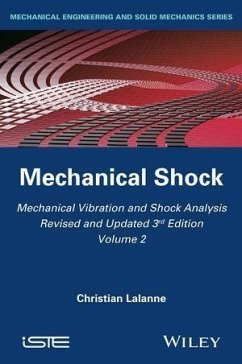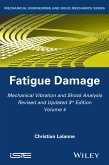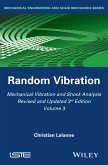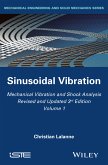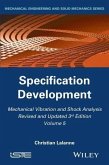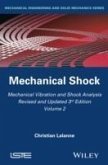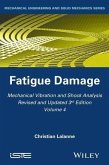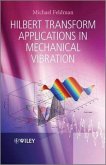Mechanical Vibration and Shock Analysis, Volume 2, Mechanical Shock (eBook, PDF)


Alle Infos zum eBook verschenken

Mechanical Vibration and Shock Analysis, Volume 2, Mechanical Shock (eBook, PDF)
- Format: PDF
- Merkliste
- Auf die Merkliste
- Bewerten Bewerten
- Teilen
- Produkt teilen
- Produkterinnerung
- Produkterinnerung

Hier können Sie sich einloggen

Bitte loggen Sie sich zunächst in Ihr Kundenkonto ein oder registrieren Sie sich bei bücher.de, um das eBook-Abo tolino select nutzen zu können.
This volume considers the shock response spectrum, its various definitions, properties and the assumptions involved in its calculation. In developing the practical application of these concepts, the forms of shock most often used with test facilities are presented together with their characteristics and indications of how to establish test configurations comparable with those in the real, measured environment. This is followed by a demonstration of how to meet these specifications using standard laboratory equipment - shock machines, electrodynamic exciters driven by a time signal or a…mehr
- Geräte: PC
- mit Kopierschutz
- eBook Hilfe
- Größe: 9.47MB
![Mechanical Vibration and Shock Analysis, Volume 4, Fatigue Damage (eBook, PDF) Mechanical Vibration and Shock Analysis, Volume 4, Fatigue Damage (eBook, PDF)]() Christian LalanneMechanical Vibration and Shock Analysis, Volume 4, Fatigue Damage (eBook, PDF)181,99 €
Christian LalanneMechanical Vibration and Shock Analysis, Volume 4, Fatigue Damage (eBook, PDF)181,99 €![Mechanical Vibration and Shock Analysis, Volume 3, Random Vibration (eBook, PDF) Mechanical Vibration and Shock Analysis, Volume 3, Random Vibration (eBook, PDF)]() Christian LalanneMechanical Vibration and Shock Analysis, Volume 3, Random Vibration (eBook, PDF)181,99 €
Christian LalanneMechanical Vibration and Shock Analysis, Volume 3, Random Vibration (eBook, PDF)181,99 €![Mechanical Vibration and Shock Analysis, Volume 1, Sinusoidal Vibration (eBook, PDF) Mechanical Vibration and Shock Analysis, Volume 1, Sinusoidal Vibration (eBook, PDF)]() Christian LalanneMechanical Vibration and Shock Analysis, Volume 1, Sinusoidal Vibration (eBook, PDF)181,99 €
Christian LalanneMechanical Vibration and Shock Analysis, Volume 1, Sinusoidal Vibration (eBook, PDF)181,99 €![Mechanical Vibration and Shock Analysis, Volume 5, Specification Development (eBook, PDF) Mechanical Vibration and Shock Analysis, Volume 5, Specification Development (eBook, PDF)]() Christian LalanneMechanical Vibration and Shock Analysis, Volume 5, Specification Development (eBook, PDF)181,99 €
Christian LalanneMechanical Vibration and Shock Analysis, Volume 5, Specification Development (eBook, PDF)181,99 €![Mechanical Vibration and Shock Analysis, Volume 2, Mechanical Shock (eBook, ePUB) Mechanical Vibration and Shock Analysis, Volume 2, Mechanical Shock (eBook, ePUB)]() Christian LalanneMechanical Vibration and Shock Analysis, Volume 2, Mechanical Shock (eBook, ePUB)181,99 €
Christian LalanneMechanical Vibration and Shock Analysis, Volume 2, Mechanical Shock (eBook, ePUB)181,99 €![Mechanical Vibration and Shock Analysis, Volume 4, Fatigue Damage (eBook, ePUB) Mechanical Vibration and Shock Analysis, Volume 4, Fatigue Damage (eBook, ePUB)]() Christian LalanneMechanical Vibration and Shock Analysis, Volume 4, Fatigue Damage (eBook, ePUB)181,99 €
Christian LalanneMechanical Vibration and Shock Analysis, Volume 4, Fatigue Damage (eBook, ePUB)181,99 €![Hilbert Transform Applications in Mechanical Vibration (eBook, PDF) Hilbert Transform Applications in Mechanical Vibration (eBook, PDF)]() Michael FeldmanHilbert Transform Applications in Mechanical Vibration (eBook, PDF)114,99 €
Michael FeldmanHilbert Transform Applications in Mechanical Vibration (eBook, PDF)114,99 €-
-
-
Dieser Download kann aus rechtlichen Gründen nur mit Rechnungsadresse in A, B, BG, CY, CZ, D, DK, EW, E, FIN, F, GR, HR, H, IRL, I, LT, L, LR, M, NL, PL, P, R, S, SLO, SK ausgeliefert werden.
- Produktdetails
- Verlag: John Wiley & Sons
- Seitenzahl: 464
- Erscheinungstermin: 16. April 2014
- Englisch
- ISBN-13: 9781118931134
- Artikelnr.: 41117794
- Verlag: John Wiley & Sons
- Seitenzahl: 464
- Erscheinungstermin: 16. April 2014
- Englisch
- ISBN-13: 9781118931134
- Artikelnr.: 41117794
- Herstellerkennzeichnung Die Herstellerinformationen sind derzeit nicht verfügbar.
V = 0 and
D
0 at the end of a pulse 115 3.2.4. Shocks with
V = 0 and
D = 0 at the end of a pulse 117 3.2.5. Notes on residual spectrum 120 3.3. Properties of SRS at high frequencies 121 3.4. Damping influence 124 3.5. Choice of damping 124 3.6. Choice of frequency range 127 3.7. Choice of the number of points and their distribution 128 3.8. Charts 131 3.9. Relation of SRS with Fourier spectrum 134 3.9.1. Primary SRS and Fourier transform 134 3.9.2. Residual SRS and Fourier transform 136 3.9.3. Comparison of the relative severity of several shocks using their Fourier spectra and their shock response spectra 139 3.10. Care to be taken in the calculation of the spectra 143 3.10.1. Main sources of errors 143 3.10.2. Influence of background noise of the measuring equipment 143 3.10.3. Influence of zero shift 145 3.11. Specific case of pyroshocks 152 3.11.1. Acquisition of the measurements 152 3.11.2. Examination of the signal before calculation of the SRS 154 3.11.3. Examination of the SRS 155 3.12. Pseudo-velocity shock spectrum 156 3.12.1. Hunt's relationship 156 3.12.2. Interest of PVSS 160 3.13. Use of the SRS for pyroshocks 162 3.14. Other propositions of spectra165 3.14.1. Pseudo-velocity calculated from the energy transmitted 165 3.14.2. Pseudo-velocity from the "input" energy at the end of a shock 165 3.14.3. Pseudo-velocity from the unit "input" energy 167 3.14.4. SRS of the "total" energy 167 Chapter 4. Development of Shock Test Specifications 175 4.1. Introduction 175 4.2. Simplification of the measured signal 176 4.3. Use of shock response spectra 178 4.3.1. Synthesis of spectra 178 4.3.2. Nature of the specification 180 4.3.3. Choice of shape 181 4.3.4. Amplitude 182 4.3.5. Duration 182 4.3.6. Difficulties 186 4.4. Other methods 187 4.4.1. Use of a swept sine 188 4.4.2. Simulation of SRS using a fast swept sine 189 4.4.3. Simulation by modulated random noise 193 4.4.4. Simulation of a shock using random vibration 194 4.4.5. Least favorable response technique 195 4.4.6. Restitution of an SRS by a series of modulated sine pulses 196 4.5. Interest behind simulation of shocks on shaker using a shock spectrum 198 Chapter 5. Kinematics of Simple Shocks 203 5.1. Introduction 203 5.2. Half-sine pulse 203 5.2.1. General expressions of the shock motion 203 5.2.2. Impulse mode 206 5.2.3. Impact mode 207 5.3. Versed sine pulse 216 5.4. Square pulse 218 5.5. Terminal peak sawtooth pulse 221 5.6. Initial peak sawtooth pulse 223 Chapter 6. Standard Shock Machines 225 6.1. Main types 225 6.2. Impact shock machines 227 6.3. High impact shock machines 237 6.3.1. Lightweight high impact shock machine 237 6.3.2. Medium weight high impact shock machine 238 6.4. Pneumatic machines 239 6.5. Specific testing facilities 241 6.6. Programmers 242 6.6.1. Half-sine pulse 242 6.6.2. TPS shock pulse 250 6.6.3. Square pulse
trapezoidal pulse 258 6.6.4. Universal shock programmer 258 Chapter 7. Generation of Shocks Using Shakers 267 7.1. Principle behind the generation of a signal with a simple shape versus time 267 7.2. Main advantages of the generation of shock using shakers 268 7.3. Limitations of electrodynamic shakers 269 7.3.1. Mechanical limitations 269 7.3.2. Electronic limitations 271 7.4. Remarks on the use of electrohydraulic shakers 271 7.5. Pre- and post-shocks 271 7.5.1. Requirements 271 7.5.2. Pre-shock or post-shock 273 7.5.3. Kinematics of the movement for symmetric pre- and post-shock 276 7.5.4. Kinematics of the movement for a pre-shock or a post-shock alone 286 7.5.5. Abacuses 288 7.5.6. Influence of the shape of pre- and post-pulses 289 7.5.7. Optimized pre- and post-shocks 292 7.6. Incidence of pre- and post-shocks on the quality of simulation 297 7.6.1. General 297 7.6.2. Influence of the pre- and post-shocks on the time history response of a one-degree-of-freedom system 297 7.6.3. Incidence on the shock response spectrum 300 Chapter 8. Control of a Shaker Using a Shock Response Spectrum 303 8.1. Principle of control using a shock response spectrum 303 8.1.1. Problems 303 8.1.2. Parallel filter method 304 8.1.3. Current numerical methods 305 8.2. Decaying sinusoid 310 8.2.1. Definition 310 8.2.2. Response spectrum 311 8.2.3. Velocity and displacement 314 8.2.4. Constitution of the total signal 315 8.2.5. Methods of signal compensation 316 8.2.6. Iterations 323 8.3. D.L. Kern and C.D. Hayes' function 324 8.3.1. Definition 324 8.3.2. Velocity and displacement 325 8.4. ZERD function 326 8.4.1. Definition 326 8.4.2. Velocity and displacement 328 8.4.3. Comparison of ZERD waveform with standard decaying sinusoid 330 8.4.4. Reduced response spectra 330 8.5. WAVSIN waveform 332 8.5.1. Definition 332 8.5.2. Velocity and displacement 333 8.5.3. Response of a one-degree-of-freedom system 335 8.5.4. Response spectrum 338 8.5.5. Time history synthesis from shock spectrum 339 8.6. SHOC waveform 340 8.6.1. Definition 340 8.6.2. Velocity and displacement 342 8.6.3. Response spectrum 343 8.6.4. Time history synthesis from shock spectrum 345 8.7. Comparison of WAVSIN, SHOC waveforms and decaying sinusoid 346 8.8. Waveforms based on the cosm(x) window 346 8.9. Use of a fast swept sine 348 8.10. Problems encountered during the synthesis of the waveforms 351 8.11. Criticism of control by SRS 353 8.12. Possible improvements 357 8.12.1. IES proposal 357 8.12.2. Specification of a complementary parameter 358 8.12.3. Remarks on the properties of the response spectrum 363 8.13. Estimate of the feasibility of a shock specified by its SRS363 8.13.1. C.D. Robbins and E.P. Vaughan's method 363 8.13.2. Evaluation of the necessary force, power and stroke 365 Chapter 9. Simulation of Pyroshocks 371 9.1. Simulations using pyrotechnic facilities 371 9.2. Simulation using metal to metal impact 375 9.3. Simulation using electrodynamic shakers 377 9.4. Simulation using conventional shock machines 378 Appendix. Similitude in Mechanics 381 A1. Conservation of materials 381 A2. Conservation of acceleration and stress 383 Mechanical Shock Tests: A Brief Historical Background 385 Bibliography 387 Index 407 Summary of other Volumes in the series 413
V = 0 and
D
0 at the end of a pulse 115 3.2.4. Shocks with
V = 0 and
D = 0 at the end of a pulse 117 3.2.5. Notes on residual spectrum 120 3.3. Properties of SRS at high frequencies 121 3.4. Damping influence 124 3.5. Choice of damping 124 3.6. Choice of frequency range 127 3.7. Choice of the number of points and their distribution 128 3.8. Charts 131 3.9. Relation of SRS with Fourier spectrum 134 3.9.1. Primary SRS and Fourier transform 134 3.9.2. Residual SRS and Fourier transform 136 3.9.3. Comparison of the relative severity of several shocks using their Fourier spectra and their shock response spectra 139 3.10. Care to be taken in the calculation of the spectra 143 3.10.1. Main sources of errors 143 3.10.2. Influence of background noise of the measuring equipment 143 3.10.3. Influence of zero shift 145 3.11. Specific case of pyroshocks 152 3.11.1. Acquisition of the measurements 152 3.11.2. Examination of the signal before calculation of the SRS 154 3.11.3. Examination of the SRS 155 3.12. Pseudo-velocity shock spectrum 156 3.12.1. Hunt's relationship 156 3.12.2. Interest of PVSS 160 3.13. Use of the SRS for pyroshocks 162 3.14. Other propositions of spectra165 3.14.1. Pseudo-velocity calculated from the energy transmitted 165 3.14.2. Pseudo-velocity from the "input" energy at the end of a shock 165 3.14.3. Pseudo-velocity from the unit "input" energy 167 3.14.4. SRS of the "total" energy 167 Chapter 4. Development of Shock Test Specifications 175 4.1. Introduction 175 4.2. Simplification of the measured signal 176 4.3. Use of shock response spectra 178 4.3.1. Synthesis of spectra 178 4.3.2. Nature of the specification 180 4.3.3. Choice of shape 181 4.3.4. Amplitude 182 4.3.5. Duration 182 4.3.6. Difficulties 186 4.4. Other methods 187 4.4.1. Use of a swept sine 188 4.4.2. Simulation of SRS using a fast swept sine 189 4.4.3. Simulation by modulated random noise 193 4.4.4. Simulation of a shock using random vibration 194 4.4.5. Least favorable response technique 195 4.4.6. Restitution of an SRS by a series of modulated sine pulses 196 4.5. Interest behind simulation of shocks on shaker using a shock spectrum 198 Chapter 5. Kinematics of Simple Shocks 203 5.1. Introduction 203 5.2. Half-sine pulse 203 5.2.1. General expressions of the shock motion 203 5.2.2. Impulse mode 206 5.2.3. Impact mode 207 5.3. Versed sine pulse 216 5.4. Square pulse 218 5.5. Terminal peak sawtooth pulse 221 5.6. Initial peak sawtooth pulse 223 Chapter 6. Standard Shock Machines 225 6.1. Main types 225 6.2. Impact shock machines 227 6.3. High impact shock machines 237 6.3.1. Lightweight high impact shock machine 237 6.3.2. Medium weight high impact shock machine 238 6.4. Pneumatic machines 239 6.5. Specific testing facilities 241 6.6. Programmers 242 6.6.1. Half-sine pulse 242 6.6.2. TPS shock pulse 250 6.6.3. Square pulse
trapezoidal pulse 258 6.6.4. Universal shock programmer 258 Chapter 7. Generation of Shocks Using Shakers 267 7.1. Principle behind the generation of a signal with a simple shape versus time 267 7.2. Main advantages of the generation of shock using shakers 268 7.3. Limitations of electrodynamic shakers 269 7.3.1. Mechanical limitations 269 7.3.2. Electronic limitations 271 7.4. Remarks on the use of electrohydraulic shakers 271 7.5. Pre- and post-shocks 271 7.5.1. Requirements 271 7.5.2. Pre-shock or post-shock 273 7.5.3. Kinematics of the movement for symmetric pre- and post-shock 276 7.5.4. Kinematics of the movement for a pre-shock or a post-shock alone 286 7.5.5. Abacuses 288 7.5.6. Influence of the shape of pre- and post-pulses 289 7.5.7. Optimized pre- and post-shocks 292 7.6. Incidence of pre- and post-shocks on the quality of simulation 297 7.6.1. General 297 7.6.2. Influence of the pre- and post-shocks on the time history response of a one-degree-of-freedom system 297 7.6.3. Incidence on the shock response spectrum 300 Chapter 8. Control of a Shaker Using a Shock Response Spectrum 303 8.1. Principle of control using a shock response spectrum 303 8.1.1. Problems 303 8.1.2. Parallel filter method 304 8.1.3. Current numerical methods 305 8.2. Decaying sinusoid 310 8.2.1. Definition 310 8.2.2. Response spectrum 311 8.2.3. Velocity and displacement 314 8.2.4. Constitution of the total signal 315 8.2.5. Methods of signal compensation 316 8.2.6. Iterations 323 8.3. D.L. Kern and C.D. Hayes' function 324 8.3.1. Definition 324 8.3.2. Velocity and displacement 325 8.4. ZERD function 326 8.4.1. Definition 326 8.4.2. Velocity and displacement 328 8.4.3. Comparison of ZERD waveform with standard decaying sinusoid 330 8.4.4. Reduced response spectra 330 8.5. WAVSIN waveform 332 8.5.1. Definition 332 8.5.2. Velocity and displacement 333 8.5.3. Response of a one-degree-of-freedom system 335 8.5.4. Response spectrum 338 8.5.5. Time history synthesis from shock spectrum 339 8.6. SHOC waveform 340 8.6.1. Definition 340 8.6.2. Velocity and displacement 342 8.6.3. Response spectrum 343 8.6.4. Time history synthesis from shock spectrum 345 8.7. Comparison of WAVSIN, SHOC waveforms and decaying sinusoid 346 8.8. Waveforms based on the cosm(x) window 346 8.9. Use of a fast swept sine 348 8.10. Problems encountered during the synthesis of the waveforms 351 8.11. Criticism of control by SRS 353 8.12. Possible improvements 357 8.12.1. IES proposal 357 8.12.2. Specification of a complementary parameter 358 8.12.3. Remarks on the properties of the response spectrum 363 8.13. Estimate of the feasibility of a shock specified by its SRS363 8.13.1. C.D. Robbins and E.P. Vaughan's method 363 8.13.2. Evaluation of the necessary force, power and stroke 365 Chapter 9. Simulation of Pyroshocks 371 9.1. Simulations using pyrotechnic facilities 371 9.2. Simulation using metal to metal impact 375 9.3. Simulation using electrodynamic shakers 377 9.4. Simulation using conventional shock machines 378 Appendix. Similitude in Mechanics 381 A1. Conservation of materials 381 A2. Conservation of acceleration and stress 383 Mechanical Shock Tests: A Brief Historical Background 385 Bibliography 387 Index 407 Summary of other Volumes in the series 413
